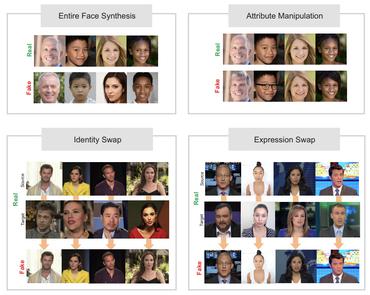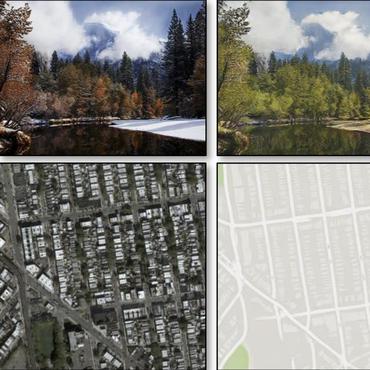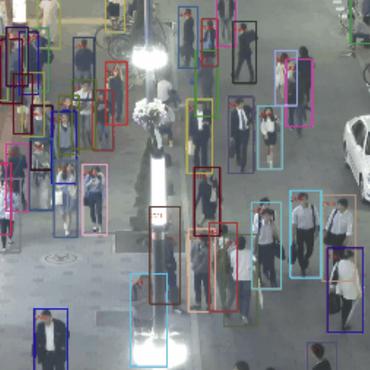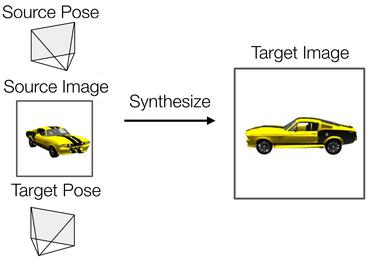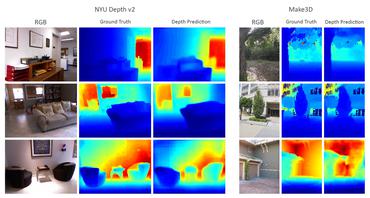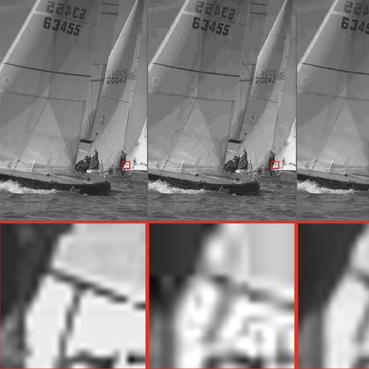Search Results for author: Sabine Süsstrunk
Found 59 papers, 31 papers with code
NoiseNCA: Noisy Seed Improves Spatio-Temporal Continuity of Neural Cellular Automata
no code implementations • 9 Apr 2024 • Ehsan Pajouheshgar, Yitao Xu, Sabine Süsstrunk
We demonstrate the effectiveness of our approach in preserving the consistency of NCA dynamics across a wide range of spatio-temporal granularities.
Emergent Dynamics in Neural Cellular Automata
no code implementations • 9 Apr 2024 • Yitao Xu, Ehsan Pajouheshgar, Sabine Süsstrunk
Neural Cellular Automata (NCA) models are trainable variations of traditional Cellular Automata (CA).
OMH: Structured Sparsity via Optimally Matched Hierarchy for Unsupervised Semantic Segmentation
no code implementations • 11 Mar 2024 • Baran Ozaydin, Tong Zhang, Deblina Bhattacharjee, Sabine Süsstrunk, Mathieu Salzmann
Our OMH yields better unsupervised segmentation performance compared to existing USS methods.
DiffusionPCR: Diffusion Models for Robust Multi-Step Point Cloud Registration
no code implementations • 5 Dec 2023 • Zhi Chen, Yufan Ren, Tong Zhang, Zheng Dang, Wenbing Tao, Sabine Süsstrunk, Mathieu Salzmann
We propose formulating PCR as a denoising diffusion probabilistic process, mapping noisy transformations to the ground truth.
Efficient Temporally-Aware DeepFake Detection using H.264 Motion Vectors
no code implementations • 17 Nov 2023 • Peter Grönquist, Yufan Ren, Qingyi He, Alessio Verardo, Sabine Süsstrunk
Video DeepFakes are fake media created with Deep Learning (DL) that manipulate a person's expression or identity.
Mesh Neural Cellular Automata
no code implementations • 6 Nov 2023 • Ehsan Pajouheshgar, Yitao Xu, Alexander Mordvintsev, Eyvind Niklasson, Tong Zhang, Sabine Süsstrunk
We propose Mesh Neural Cellular Automata (MeshNCA), a method that directly synthesizes dynamic textures on 3D meshes without requiring any UV maps.
Exploiting the Signal-Leak Bias in Diffusion Models
no code implementations • 27 Sep 2023 • Martin Nicolas Everaert, Athanasios Fitsios, Marco Bocchio, Sami Arpa, Sabine Süsstrunk, Radhakrishna Achanta
This enables us to generate images with more varied brightness, and images that better match a desired style or color.
Vision Transformer Adapters for Generalizable Multitask Learning
no code implementations • ICCV 2023 • Deblina Bhattacharjee, Sabine Süsstrunk, Mathieu Salzmann
We introduce the first multitasking vision transformer adapters that learn generalizable task affinities which can be applied to novel tasks and domains.
Dense Multitask Learning to Reconfigure Comics
no code implementations • 16 Jul 2023 • Deblina Bhattacharjee, Sabine Süsstrunk, Mathieu Salzmann
In this paper, we develop a MultiTask Learning (MTL) model to achieve dense predictions for comics panels to, in turn, facilitate the transfer of comics from one publication channel to another by assisting authors in the task of reconfiguring their narratives.
InNeRF360: Text-Guided 3D-Consistent Object Inpainting on 360-degree Neural Radiance Fields
no code implementations • 24 May 2023 • Dongqing Wang, Tong Zhang, Alaa Abboud, Sabine Süsstrunk
We propose InNeRF360, an automatic system that accurately removes text-specified objects from 360-degree Neural Radiance Fields (NeRF).
De-coupling and De-positioning Dense Self-supervised Learning
no code implementations • 29 Mar 2023 • Congpei Qiu, Tong Zhang, Wei Ke, Mathieu Salzmann, Sabine Süsstrunk
Dense Self-Supervised Learning (SSL) methods address the limitations of using image-level feature representations when handling images with multiple objects.
Spatiotemporal Self-supervised Learning for Point Clouds in the Wild
1 code implementation • CVPR 2023 • Yanhao Wu, Tong Zhang, Wei Ke, Sabine Süsstrunk, Mathieu Salzmann
In this paper, we introduce an SSL strategy that leverages positive pairs in both the spatial and temporal domain.
NEMTO: Neural Environment Matting for Novel View and Relighting Synthesis of Transparent Objects
no code implementations • ICCV 2023 • Dongqing Wang, Tong Zhang, Sabine Süsstrunk
We propose NEMTO, the first end-to-end neural rendering pipeline to model 3D transparent objects with complex geometry and unknown indices of refraction.
TempSAL -- Uncovering Temporal Information for Deep Saliency Prediction
1 code implementation • 5 Jan 2023 • Bahar Aydemir, Ludo Hoffstetter, Tong Zhang, Mathieu Salzmann, Sabine Süsstrunk
Deep saliency prediction algorithms complement the object recognition features, they typically rely on additional information, such as scene context, semantic relationships, gaze direction, and object dissimilarity.
Diffusion in Style
no code implementations • ICCV 2023 • Martin Nicolas Everaert, Marco Bocchio, Sami Arpa, Sabine Süsstrunk, Radhakrishna Achanta
Not adapting this initial latent tensor to the style makes fine-tuning slow, expensive, and impractical, especially when only a few target style images are available.
TempSAL - Uncovering Temporal Information for Deep Saliency Prediction
1 code implementation • CVPR 2023 • Bahar Aydemir, Ludo Hoffstetter, Tong Zhang, Mathieu Salzmann, Sabine Süsstrunk
Deep saliency prediction algorithms complement the object recognition features, they typically rely on additional information such as scene context, semantic relationships, gaze direction, and object dissimilarity.
![]() Ranked #1 on
Saliency Prediction
on SALICON
Ranked #1 on
Saliency Prediction
on SALICON
DSI2I: Dense Style for Unpaired Image-to-Image Translation
no code implementations • 26 Dec 2022 • Baran Ozaydin, Tong Zhang, Sabine Süsstrunk, Mathieu Salzmann
To stylize the source content with the exemplar style, we extract unsupervised cross-domain semantic correspondences and warp the exemplar style to the source content.
VolRecon: Volume Rendering of Signed Ray Distance Functions for Generalizable Multi-View Reconstruction
1 code implementation • CVPR 2023 • Yufan Ren, Fangjinhua Wang, Tong Zhang, Marc Pollefeys, Sabine Süsstrunk
The success of the Neural Radiance Fields (NeRF) in novel view synthesis has inspired researchers to propose neural implicit scene reconstruction.
DyNCA: Real-time Dynamic Texture Synthesis Using Neural Cellular Automata
no code implementations • CVPR 2023 • Ehsan Pajouheshgar, Yitao Xu, Tong Zhang, Sabine Süsstrunk
Current Dynamic Texture Synthesis (DyTS) models can synthesize realistic videos.
PoGaIN: Poisson-Gaussian Image Noise Modeling from Paired Samples
1 code implementation • 10 Oct 2022 • Nicolas Bähler, Majed El Helou, Étienne Objois, Kaan Okumuş, Sabine Süsstrunk
To fill this gap, we derive a novel, cumulant-based, approach for Poisson-Gaussian noise modeling from paired image samples.
DSR: Towards Drone Image Super-Resolution
1 code implementation • 25 Aug 2022 • Xiaoyu Lin, Baran Ozaydin, Vidit Vidit, Majed El Helou, Sabine Süsstrunk
It would enable drones to fly higher covering larger fields of view, while maintaining a high image quality.
Fast Adversarial Training with Adaptive Step Size
no code implementations • 6 Jun 2022 • Zhichao Huang, Yanbo Fan, Chen Liu, Weizhong Zhang, Yong Zhang, Mathieu Salzmann, Sabine Süsstrunk, Jue Wang
While adversarial training and its variants have shown to be the most effective algorithms to defend against adversarial attacks, their extremely slow training process makes it hard to scale to large datasets like ImageNet.
MulT: An End-to-End Multitask Learning Transformer
no code implementations • CVPR 2022 • Deblina Bhattacharjee, Tong Zhang, Sabine Süsstrunk, Mathieu Salzmann
At the heart of our approach is a shared attention mechanism modeling the dependencies across the tasks.
Leverage Your Local and Global Representations: A New Self-Supervised Learning Strategy
no code implementations • CVPR 2022 • Tong Zhang, Congpei Qiu, Wei Ke, Sabine Süsstrunk, Mathieu Salzmann
In essence, this strategy ignores the fact that two crops may truly contain different image information, e. g., background and small objects, and thus tends to restrain the diversity of the learned representations.
RC-MVSNet: Unsupervised Multi-View Stereo with Neural Rendering
1 code implementation • 8 Mar 2022 • Di Chang, Aljaž Božič, Tong Zhang, Qingsong Yan, Yingcong Chen, Sabine Süsstrunk, Matthias Nießner
Finding accurate correspondences among different views is the Achilles' heel of unsupervised Multi-View Stereo (MVS).
Robust Binary Models by Pruning Randomly-initialized Networks
1 code implementation • 3 Feb 2022 • Chen Liu, Ziqi Zhao, Sabine Süsstrunk, Mathieu Salzmann
In this paper, we introduce an approach to obtain robust yet compact models by pruning randomly-initialized binary networks.
Image Denoising with Control over Deep Network Hallucination
1 code implementation • 2 Jan 2022 • Qiyuan Liang, Florian Cassayre, Haley Owsianko, Majed El Helou, Sabine Süsstrunk
In this framework, we exploit the outputs of a deep denoising network alongside an image convolved with a reliable filter.
On the Impact of Hard Adversarial Instances on Overfitting in Adversarial Training
no code implementations • 14 Dec 2021 • Chen Liu, Zhichao Huang, Mathieu Salzmann, Tong Zhang, Sabine Süsstrunk
This lets us show that the decay in generalization performance of adversarial training is a result of the model's attempt to fit hard adversarial instances.
Optimizing Latent Space Directions For GAN-based Local Image Editing
1 code implementation • 24 Nov 2021 • Ehsan Pajouheshgar, Tong Zhang, Sabine Süsstrunk
Generative Adversarial Network (GAN) based localized image editing can suffer from ambiguity between semantic attributes.
Estimating Image Depth in the Comics Domain
1 code implementation • 7 Oct 2021 • Deblina Bhattacharjee, Martin Everaert, Mathieu Salzmann, Sabine Süsstrunk
Estimating the depth of comics images is challenging as such images a) are monocular; b) lack ground-truth depth annotations; c) differ across different artistic styles; d) are sparse and noisy.
 Ranked #1 on
Depth Estimation
on eBDtheque
Ranked #1 on
Depth Estimation
on eBDtheque
Improving Adversarial Defense with Self-supervised Test-time Fine-tuning
no code implementations • 29 Sep 2021 • Zhichao Huang, Chen Liu, Mathieu Salzmann, Sabine Süsstrunk, Tong Zhang
Although adversarial training and its variants currently constitute the most effective way to achieve robustness against adversarial attacks, their poor generalization limits their performance on the test samples.
Fidelity Estimation Improves Noisy-Image Classification With Pretrained Networks
1 code implementation • 1 Jun 2021 • Xiaoyu Lin, Deblina Bhattacharjee, Majed El Helou, Sabine Süsstrunk
Furthermore, as proof of concept, we show that when using our oracle fidelity map we even outperform the fully retrained methods, whether trained on noisy or restored images.
Modeling Object Dissimilarity for Deep Saliency Prediction
1 code implementation • 8 Apr 2021 • Bahar Aydemir, Deblina Bhattacharjee, Tong Zhang, Seungryong Kim, Mathieu Salzmann, Sabine Süsstrunk
Saliency prediction has made great strides over the past two decades, with current techniques modeling low-level information, such as color, intensity and size contrasts, and high-level ones, such as attention and gaze direction for entire objects.
Deep Gaussian Denoiser Epistemic Uncertainty and Decoupled Dual-Attention Fusion
1 code implementation • 12 Jan 2021 • Xiaoqi Ma, Xiaoyu Lin, Majed El Helou, Sabine Süsstrunk
While novel denoising networks were designed for real images coming from different distributions, or for specific applications, comparatively small improvement was achieved on Gaussian denoising.
BIGPrior: Towards Decoupling Learned Prior Hallucination and Data Fidelity in Image Restoration
2 code implementations • 3 Nov 2020 • Majed El Helou, Sabine Süsstrunk
Our method, though partly reliant on the quality of the generative network inversion, is competitive with state-of-the-art supervised and task-specific restoration methods.
AIM 2020: Scene Relighting and Illumination Estimation Challenge
2 code implementations • 27 Sep 2020 • Majed El Helou, Ruofan Zhou, Sabine Süsstrunk, Radu Timofte, Mahmoud Afifi, Michael S. Brown, Kele Xu, Hengxing Cai, Yuzhong Liu, Li-Wen Wang, Zhi-Song Liu, Chu-Tak Li, Sourya Dipta Das, Nisarg A. Shah, Akashdeep Jassal, Tongtong Zhao, Shanshan Zhao, Sabari Nathan, M. Parisa Beham, R. Suganya, Qing Wang, Zhongyun Hu, Xin Huang, Yaning Li, Maitreya Suin, Kuldeep Purohit, A. N. Rajagopalan, Densen Puthussery, Hrishikesh P. S, Melvin Kuriakose, Jiji C. V, Yu Zhu, Liping Dong, Zhuolong Jiang, Chenghua Li, Cong Leng, Jian Cheng
The first track considered one-to-one relighting; the objective was to relight an input photo of a scene with a different color temperature and illuminant orientation (i. e., light source position).
Volumetric Transformer Networks
no code implementations • ECCV 2020 • Seungryong Kim, Sabine Süsstrunk, Mathieu Salzmann
We design our VTN as an encoder-decoder network, with modules dedicated to letting the information flow across the feature channels, to account for the dependencies between the semantic parts.
On the Loss Landscape of Adversarial Training: Identifying Challenges and How to Overcome Them
1 code implementation • NeurIPS 2020 • Chen Liu, Mathieu Salzmann, Tao Lin, Ryota Tomioka, Sabine Süsstrunk
We analyze the influence of adversarial training on the loss landscape of machine learning models.
VIDIT: Virtual Image Dataset for Illumination Transfer
2 code implementations • 11 May 2020 • Majed El Helou, Ruofan Zhou, Johan Barthas, Sabine Süsstrunk
Deep image relighting is gaining more interest lately, as it allows photo enhancement through illumination-specific retouching without human effort.
Editing in Style: Uncovering the Local Semantics of GANs
2 code implementations • CVPR 2020 • Edo Collins, Raja Bala, Bob Price, Sabine Süsstrunk
Focusing on StyleGAN, we introduce a simple and effective method for making local, semantically-aware edits to a target output image.
Divergence-Based Adaptive Extreme Video Completion
no code implementations • 14 Apr 2020 • Majed El Helou, Ruofan Zhou, Frank Schmutz, Fabrice Guibert, Sabine Süsstrunk
Extreme image or video completion, where, for instance, we only retain 1% of pixels in random locations, allows for very cheap sampling in terms of the required pre-processing.
Evaluating Salient Object Detection in Natural Images with Multiple Objects having Multi-level Saliency
1 code implementation • 19 Mar 2020 • Gökhan Yildirim, Debashis Sen, Mohan Kankanhalli, Sabine Süsstrunk
In this paper, we corroborate based on three subjective experiments on a novel image dataset that objects in natural images are inherently perceived to have varying levels of importance.
Stochastic Frequency Masking to Improve Super-Resolution and Denoising Networks
2 code implementations • ECCV 2020 • Majed El Helou, Ruofan Zhou, Sabine Süsstrunk
Super-resolution and denoising are ill-posed yet fundamental image restoration tasks.
W2S: Microscopy Data with Joint Denoising and Super-Resolution for Widefield to SIM Mapping
2 code implementations • 12 Mar 2020 • Ruofan Zhou, Majed El Helou, Daniel Sage, Thierry Laroche, Arne Seitz, Sabine Süsstrunk
To study JDSR on microscopy data, we propose such a novel JDSR dataset, Widefield2SIM (W2S), acquired using a conventional fluorescence widefield and SIM imaging.
AL2: Progressive Activation Loss for Learning General Representations in Classification Neural Networks
1 code implementation • 7 Mar 2020 • Majed El Helou, Frederike Dümbgen, Sabine Süsstrunk
We propose to regularize this representation in the last feature layer before classification layers.
Image Restoration using Plug-and-Play CNN MAP Denoisers
1 code implementation • 18 Dec 2019 • Siavash Bigdeli, David Honzátko, Sabine Süsstrunk, L. Andrea Dunbar
Plug-and-play denoisers can be used to perform generic image restoration tasks independent of the degradation type.
Training Provably Robust Models by Polyhedral Envelope Regularization
1 code implementation • 10 Dec 2019 • Chen Liu, Mathieu Salzmann, Sabine Süsstrunk
Training certifiable neural networks enables one to obtain models with robustness guarantees against adversarial attacks.
Blind Universal Bayesian Image Denoising with Gaussian Noise Level Learning
2 code implementations • 5 Jul 2019 • Majed El Helou, Sabine Süsstrunk
Blind and universal image denoising consists of using a unique model that denoises images with any level of noise.
 Ranked #1 on
Grayscale Image Denoising
on BSD68 sigma40
Ranked #1 on
Grayscale Image Denoising
on BSD68 sigma40
Drone Shadow Tracking
1 code implementation • 20 May 2019 • Xiaoyan Zou, Ruofan Zhou, Majed El Helou, Sabine Süsstrunk
In this paper, we incorporate knowledge of the shadow's physical properties, in the form of shadow detection masks, into a correlation-based tracking algorithm.
Fast and Efficient Zero-Learning Image Fusion
1 code implementation • 9 May 2019 • Fayez Lahoud, Sabine Süsstrunk
Our method generates a single image containing features from multiple sources.
Self-Binarizing Networks
no code implementations • 2 Feb 2019 • Fayez Lahoud, Radhakrishna Achanta, Pablo Márquez-Neila, Sabine Süsstrunk
To obtain similar binary networks, existing methods rely on the sign activation function.
Detecting Memorization in ReLU Networks
no code implementations • ICLR 2019 • Edo Collins, Siavash Arjomand Bigdeli, Sabine Süsstrunk
We propose a new notion of `non-linearity' of a network layer with respect to an input batch that is based on its proximity to a linear system, which is reflected in the non-negative rank of the activation matrix.
Fourier-Domain Optimization for Image Processing
1 code implementation • 11 Sep 2018 • Majed El Helou, Frederike Dümbgen, Radhakrishna Achanta, Sabine Süsstrunk
Image optimization problems encompass many applications such as spectral fusion, deblurring, deconvolution, dehazing, matting, reflection removal and image interpolation, among others.
Deep Feature Factorization For Concept Discovery
2 code implementations • ECCV 2018 • Edo Collins, Radhakrishna Achanta, Sabine Süsstrunk
We propose Deep Feature Factorization (DFF), a method capable of localizing similar semantic concepts within an image or a set of images.
 Ranked #6 on
Unsupervised Human Pose Estimation
on Tai-Chi-HD
Ranked #6 on
Unsupervised Human Pose Estimation
on Tai-Chi-HD
 Unsupervised Facial Landmark Detection
Unsupervised Facial Landmark Detection
 Unsupervised Human Pose Estimation
+1
Unsupervised Human Pose Estimation
+1
Mirror, Mirror, on the Wall, Who's Got the Clearest Image of Them All? - A Tailored Approach to Single Image Reflection Removal
no code implementations • 29 May 2018 • Daniel Heydecker, Georg Maierhofer, Angelica I. Aviles-Rivero, Qingnan Fan, Dong-Dong Chen, Carola-Bibiane Schönlieb, Sabine Süsstrunk
Removing reflection artefacts from a single image is a problem of both theoretical and practical interest, which still presents challenges because of the massively ill-posed nature of the problem.
Deep Residual Network for Joint Demosaicing and Super-Resolution
1 code implementation • 19 Feb 2018 • Ruofan Zhou, Radhakrishna Achanta, Sabine Süsstrunk
By training on high-quality samples, our deep residual demosaicing and super-resolution network is able to recover high-quality super-resolved images from low-resolution Bayer mosaics in a single step without producing the artifacts common to such processing when the two operations are done separately.
Uniform Information Segmentation
no code implementations • 27 Nov 2016 • Radhakrishna Achanta, Pablo Márquez-Neila, Pascal Fua, Sabine Süsstrunk
Since information is a natural way of measuring image complexity, our proposed algorithm leads to image segments that are smaller and denser in areas of high complexity and larger in homogeneous regions, thus simplifying the image while preserving its details.
God(s) Know(s): Developmental and Cross-Cultural Patterns in Children Drawings
no code implementations • 11 Nov 2015 • Ksenia Konyushkova, Nikolaos Arvanitopoulos, Zhargalma Dandarova Robert, Pierre-Yves Brandt, Sabine Süsstrunk
This paper introduces a novel approach to data analysis designed for the needs of specialists in psychology of religion.
Incorporating Near-Infrared Information into Semantic Image Segmentation
no code implementations • 24 Jun 2014 • Neda Salamati, Diane Larlus, Gabriela Csurka, Sabine Süsstrunk
Based on a state-of-the-art segmentation framework and a novel manually segmented image database (both indoor and outdoor scenes) that contain 4-channel images (RGB+NIR), we study how to best incorporate the specific characteristics of the NIR response.



